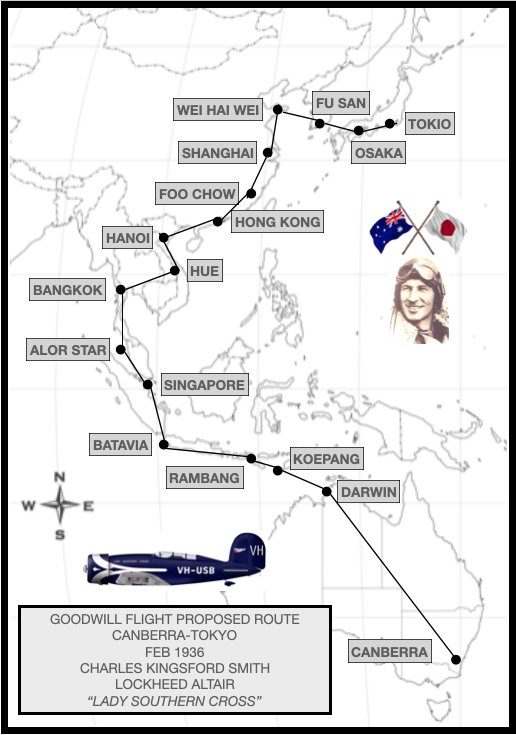
Flights
Never Flown.
The Proposed Flight to Japan
by Mick Raftery
Graphic by Mick Raftery
| The
life and times of Sir Charles Kingsford Smith have been well documented,
as have all his flights both pioneering and commercial. The following
is a brief summary of the proposed and little known aerial adventures
that were never entered into his logbooks or featured among his career
highlights. In July 1930, a proposal for a flight to Japan first appeared at the conclusion of the first aerial circumnavigation of the globe through both hemispheres. The Southern Cross had arrived at Oakland from the east, two years after departing to the west from the same airfield. Smithy's brother, Richard Harold Kingsford Smith of Oakland, informed the press that Smithy had been approached by "an eastern aircraft company”, to pilot an experimental aircraft with either three or four engines and with a 6000 mile range, now under construction, from California to Japan on a non-stop flight. This proposed flight was to occur in June 1931. In January 1933, the South Australian Premier, Mr. Lionel Hill, received a letter from Kingsford Smith outlining a proposal for a two to three month tour, commencing in April, of the Far East, including Japan, to promote trade. The letter stated that the tour would require sufficient support from business interests. The proposal was referred to the South Australian Chamber of Manufacturers who declined to support the tour as they were associated with sending a “show boat” to the Far East. In December 1933, The Right Honourable Joseph Lyons, Prime Minister of Australia, received a suggestion from Kingsford Smith, that he (CKS) should fly the proposed parliamentary delegation, led by Sir John G. Latham, Federal Attorney-General, to Japan in the Southern Cross. Capt. Edgar Johnson, Controller of Civil Aviation, had doubts whether the Southern Cross could carry the required personnel, despite it being otherwise suitable for the trip. In July 1935, Mr. K. Sato, Assistant Managing Editor of the Osaka Mainichi newspaper, English edition, stated his paper was trying to facilitate arrangements in Japan for the Kingsford Smith goodwill flight. Mr. Sato had returned from New Zealand in July 1935 after promoting a forthcoming exhibition in Japan, with a budget of up to £20 000, to promote better relations with Australia. During the July 1935 voyage to New Zealand on the Aorangi, Kingsford Smith met Japanese mercantile marine officers who were en route to Auckland to take delivery of the Union Co. steamer Kiotoke. They commenced his studies of the Japanese language to enable a working knowledge of the language, in anticipation of the forthcoming goodwill tour. Kingsford Smith announced that the persons who would accompany him on the goodwill flight to Japan proposed for Jan/Feb Festival season in 1936 were Beau Sheil, John Stannage and an engineer, presumably Tommy Pethybridge. He also stated that an Australian Government representative would be invited. In August 1935, Flying Officer Beau Sheil, outlined the proposed route of the goodwill flight to Japan in the Lockheed Altair Lady Southern Cross. However, he stated that if Civil Aviation authorities denied the granting a Certificate of Airworthiness for the Altair, endeavours would be made to sell the Lady Southern Cross in Japan. Details of the goodwill flight were featured in an interview in a long-distance radio phone call between Kingsford Smith, in Los Angeles, and the Tokyo Nichi-Nichi newspaper. Also reported were plans to convert the Lady Southern Cross fuselage to carry four passengers and baggage. Lockheed had offered, at half price, a new Orion fuselage to convert the Altair for increased passenger numbers. Beau Shiel reported that this was unaffordable and the conversion “did not work out”. (Refer 16AUG35 in main chronology) In October 1935, an offer to purchase the Lady Southern Cross for £8 000 was made by a group of English newspapers. The sale would include Kingsford Smith being employed to fly between England and Abyssinia (modern Ethiopia) carrying news photos and dispatches of the Italo-Abyssinian war. Kingsford Smith declined due to his RAAF rank of Air Commodore and unwillingness to embarrass British or Australian feelings and international reactions by entering a war zone. In January 1936, Lady Mary Kingsford Smith received a presentation gift from the Japanese newspaper Osaka Mainichi, being an album bound in tapestry and handworked in gold thread. Kingsford Smith had written an article for this newspaper in anticipation of his goodwill flight to Japan in early 1936. The newspaper directors had hoped Kingsford Smith would have been in Sydney to receive this gift, however his disappearance and unsuccessful searches for Kingsford Smith, Pethybridge and the Lady Southern Cross in late 1935 prevented this personal handover. Mary was reported to have said she would treasure the gift and eventually pass it on to her son, Charles Arthur, who had just turned three years of age. In February 1936, a Singapore to Japan goodwill flight was undertaken by Air Commodore Sydney W. Smith, RAF Commander Far East, leading three Short Singapore III flying boats from 205 Squadron. This flight was cancelled after arrival in Shanghai, China when a military coup in Japan prevented the visit. Air Commodore Smith had played a prominent role in the search for Kingsford Smith and the Lady Southern Cross. |
